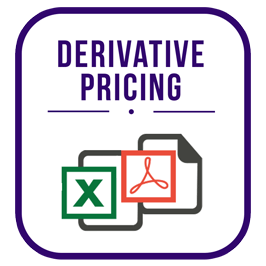Monte Carlo Simulation with Option Pricing - Package
About the Course
The “Derivative Pricing – Binomial Trees – Efficient Approach” course with supporting EXCEL file focuses on an alternative method of implementing a two-dimensional binomial tree compared to the traditional method of building a binomial tree in EXCEL presented in most option pricing text books.
The alternate approach is based on the techniques documented by Professor Mark Broadie at Columbia Business School as part of his coursework in Security Pricing and Computational Finance courses at Columbia University. The calculation methodology is more efficient as it allows for the extension of a simple 3 step tree to a 50 – 100 step option pricing tree in a few minutes.
The course walks through the construction of the tree to price European calls and put options. The model is then updated to price American and Knock out and Knock in (Sudden Death) options.
The “Monte Carlo Simulation – Models and Applications” course begins with a walkthrough of the construction of a basic simulator in EXCEL for stock prices. It discusses how the model may be extended for simulating currency rates and commodity prices and why it cannot be used for simulating interest rates. The similarities between the Monte Carlo simulation model, the Black Scholes model and the Binomial Tree Approach are considered.
Next, a hybrid model that randomly picks returns from the actual historical return distribution instead of using the normal distribution assumption that the original simulator utilizes is constructed and back testing is performed to compare the results with the original model.
Basic option terminology and the Black Scholes option pricing formula are reviewed before an in depth analysis of the Black Scholes model risk adjusted probabilities is conducted using a Monte Carlo simulator.
The Monte simulation model is then used in a variety of applications such as pricing vanilla and exotic options (including using convergence and variance reduction techniques to improve the accuracy of and time to convergence to the true results), calculating Value at Risk for derivative instruments, analyzing hedge effectiveness for fuel costs for the aviation industry, simulating interest rate term structure and forecasting monetary policy rates.
This course also includes the following EXCEL files:
- Monte Carlo simulation using the historical distribution
- Simulating the terminal price of a commodity
- Simulating the terminal price of a currency
- Simulating the terminal price of an equity
- The supporting excel file for the alternate binomial tree methodology used to price European calls and put options, American and knock out and knock in (Sudden Death) options.
- Option pricing using the Traditional Binomial Tree approach
- Option pricing using the Black-Scholes option pricing formula
- Deriving the solution of the closed-form Black Scholes European call option price formula using a Monte Carlo Simulator. The purpose is to build intuition of how the formula works & what the risk adjusted probabilities N(d1) and N(d2) mean.
- An example of how the Ladder call option may be priced using Monte Carlo Simulation in EXCEL
- The “Exotic Option Pricing using Monte Carlo Simulation” EXCEL file which calculates the option prices for vanilla and exotic options including Asian, Barrier, Look back & Chooser options.
Learning Objectives
After taking this course you will be able to:
- Understand and appreciate the calculation efficiency of the alternate binomial trees approach
- Calculate the price of various options using this approach including European call & put options, American call & put options, capped calls with automatic exercise, knock in and knock out options
- Price European and American call and put options using the traditional binomial tree approach
- Price European call, put and various barrier options using the Black Scholes formula
- Calculate the Greeks for these options using the Black Scholes formula & binomial trees
- Construct a basic Monte Carlo simulator in EXCEL to determine possible future price paths for equities, commodities or currencies
- Build a hybrid Monte Carlo simulation model that uses the actual historical return distribution instead of the normal distribution assumption used in the original version
- Explain and analyze Black Scholes risk adjusted probabilities using a Monte Carlo simulation model
- Price vanilla and exotic options using a Monte Carlo simulation model
- Apply convergence and variance reduction techniques to improve the accuracy of Monte Carlo simulation results
- Calculate Value at Risk (VaR) for futures and options using the Monte Carlo simulation approach
- Calculate Value at Risk using the Monte Carlo simulation model that makes use of the actual historical return distribution and compare the result to results from the original Monte Carlo simulation and Historical Simulation VaR approaches
- Analyze the effectiveness of entering a hedging program for the aviation industry using Monte Carlo simulation
- Simulate the term structure of interest rates using the Cox-Ingersoll Ross (CIR) interest rate model & the Heath-Jarrow-Merton (HJM) multifactor interest rate model
- Forecast the monetary policy rate using a simplified Monte Carlo simulation model
Prerequisites
The candidate should have some familiarity with basic derivative products and their pricing and be comfortable with basic mathematics, statistics, probability and EXCEL.
Target Audience
The course is aimed at professionals who deal with pricing, valuation and risk issues related to structured fixed income and foreign exchange transactions, as well as individuals responsible for capital allocation, limit setting and risk management within banks, insurance companies, mutual funds, as well as finance departments of non-financial organizations.

